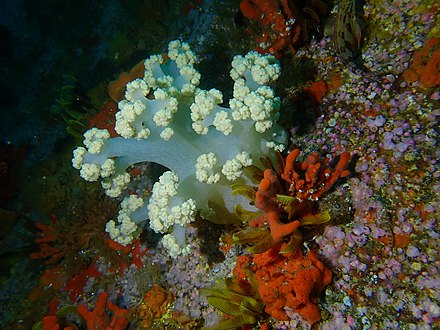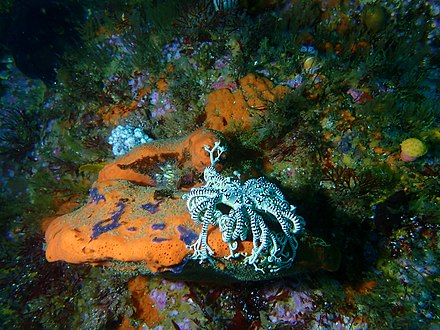Diving the Cape Peninsula and False Bay/Off-Whittle Ridge
Diving the Cape Peninsula and False Bay/Off-Whittle Ridge
The dive site Off-Whittle Ridge is an offshore rocky reef in False Bay, near Cape Town in the Western Cape province of South Africa.
Understand




 See also: Diving the Cape Peninsula and False Bay#Understand
See also: Diving the Cape Peninsula and False Bay#Understand
An area of reef to the northwest of Whittle Rock which has probably never been dived previously. The highest point is at about 19 m depth, and the surrounding sand is at about 30 m. The extent of the reef is not yet known, but it will be considerably smaller than the main reef at Whittle Rock.
Position
Off-Whittle Ridge 📍: S34°14.364' E18°34.847'. Northeast of Whittle Rock.
This site is not in a Marine Protected Area. A permit is not required.
Name
The name "Off-Whittle Ridge" is a simple geographical description of the reef. At the time of naming it was the only dive site near Whittle Rock that was far enough away to be considered a separate area.
Depth
Maximum depth is probably deeper than 30 m at the sand, and the top of the ridge is about 19 m. Average depth of a dive is likely to be about 25 m, excluding ascent.
Visibility
Visibility is may be better than on the inshore reefs, but as with any False Bay reef, it is not very predictable, and there may be better visibility at the bottom below a dirty surface layer of plankton, which can follow a period of strong sunshine. Visibility can exceed 20 m on rare and unpredictable occasions. The colour of the surface water is not a reliable indicator of the visibility at depth.
At times the variation in visibility between sites can be surprising. There have been days when visibility at the Fleur has been less than 2 m, and very dark below 30 m, while only 6.5 km away at Whittle Rock, visibility was over 15 m at 30 m depth, and brightly illuminated by sunlight.
Topography
The pinnacle of this fairly extensive area of reef is in the form of a ridge running roughly north-south with a cluster of large boulders to the northeast, and is quite small. The topography is rugged in the ridge area, with a wall down to about 25 m on the west side. The sand at 30 m is reportedly not very far away to the southeast.
Geology: Granite corestone outcrop of the Pre-Cambrian Peninsula pluton
Conditions
The site is exposed to wind and waves from all directions, and swells from the southwest, however it is quite deep, so short period waves will not affect conditions on the bottom greatly. Low short swell and light wind is best. The prevailing long period swell is from the southwest, and if long enough can cause surge even on the deep reef. Other waves are generally short period wind waves and chop, but the reef is far enough offshore for a vicious chop to develop in a strong wind, which can be very uncomfortable on the ride back to Simon's Town. The area is protected from north-westerly swell, and to a lesser extent south-westerly swell by the Cape Peninsula, but longer period south-westerly swell will refract round Cape Point, and though attenuated, will reach this area.
Surface currents have been measured at up to about 1.5 kilometers per hour, caused by recent wind, and in a similar direction, offset in an anticlockwise Ekman spiral by the Coriolis effect (the current is offset more at greater depth, but proportionately weaker). The skipper should drop divers off a bit up-current of the shotline, which may not be quite the same as upwind of it, and the drift direction of a boat with significant windage is not quite the same as the drift direction of an almost completely immersed diver. Occasionally the current will extend right down to the deep reef, but usually it is shallow.
Water temperature may vary with depth. A thermocline develops in midsummer, gets deeper in autumn, and dissipates in winter. The visibility may also change significantly below the thermocline. The surface at Whittle Rock nearby can be 18 or 19°C with 10 or 11°C at the bottom, but the difference is more likely to be 5°C or less. Conditions at depth are not easily predictable, and may be better or worse than near the surface. There can be a plankton bloom in the surface layers and a sudden improvement in visibility from 3 m or less to over 10 m in the cold bottom water, or, less often, fairly clean surface water, but dirty at depth. This dirty bottom water is more common at deeper offshore sites in False Bay, such as the wrecks of the Fleur (40 m), General Botha (54 m), and Bloemfontein (57 m). The depth of the thermocline is also not very predictable, but has been known to be between 12 and 20 m in late summer.
In winter the water may be the same temperature from top to bottom, and as there is less sunlight to power the phytoplankton blooms, the visibility and natural illumination can be better even though there is less light. There is no specific time of year for diving this site, you just have to wait for low swell and light winds, and take your chances with visibility.
A long period swell may produce significant surge at depth, depending on the local topography. The reef is far enough to the west of False Bay that the diffraction of south westerly waves around Cape Point and refraction over Rocky Bank can dissipate a fair amount of the wave energy that would otherwise cross the reef, but the amount is not easily predictable, though the shoreline break on the Strandfontein coast can give some indication.
Get in
See also: Diving the Cape Peninsula and False Bay#Boat dives
This site is only accessible by boat. It is about 15.6 km from Simon's Town Jetty, or 10 km from Miller's Point slipway. On a good day in a fast boat it is about a half hour run from Simon's Town Jetty.
Anchoring is not recommended. The holding ground is unreliable, and there is a good chance that the anchor will either drag or foul, possibly both, and a rope rode may chafe through during a dive. This is a site where only the suicidally foolhardy would dive from an unattended boat, and besides dragging or fouling, the anchor tackle will do undesirable and unnecessary ecological damage. Leave the boat in the charge of a competent person who will be able to pick up stray divers and call for help in an emergency.
See
Marine life
See also: Diving the Cape Peninsula and False Bay#The marine ecology
On the day of first survey there were large numbers of basket stars scattered all over the ridge, and some magnificent specimens of white cauliflower soft corals on the sides of the ridge. There were large shoals of juvenile strepie and moderate shoals of hottentot seabream and panga, several roman, including at least one large male, and scattered fransmadam, puffadder shysharks, twotone finger-fins, redfingers, a small red steenbras, and several bank steenbras, Good variety of invertebrates, including gorgonian sea fans and cauliflower soft corals, and a few species of nudibranch. Walls often dominated by the usual elegant feather stars, with strawberry anemones and various sponges and ascidians.
Photography
Suggested routes
Stay safe
Hazards
See also: Diving the Cape Peninsula and False Bay#Stay safe
Skills
Equipment
See also: Diving the Cape Peninsula and False Bay#Equipment
Nearby
Other offshore dive sites of False Bay:
Back to the Alphabetical list of sites, or list of reef dive sites in the Whittle Rock and surrounds offshore area
Other regional dive sites: